Dutch Dance Costumes
The Netherlands is divided into 12 provinces, 8 of which are represented in costume by the dancers in our festival. Many people are curious as to how the costumes are made and their cost. Each one of the dancers costumes is hand made to fit that individual. In addition to fabrics, wooden shoes and in some cases, specially crafted hats or other accessories must be purchased. If the dancer or a family member makes the costume they will save money in seamstress fees. Total costume costs, including seamstress fees, shoes and all accessories range from $180–$240 per costume. Dancer costumes are cut from hand made patterns, available only from the Tulip Time Festival Costume Directors. Before a dancer can perform, the costume is inspected to assure that it meets the standard for fit, function, safety, authenticity and construction. A question frequently asked by tourists watching the dancers is whether the girls from Dutch descent commonly have such thick ankles. The answer is, of course, no. In order to walk and dance comfortably, in the wooden shoes, they all wear several pair of heavy socks. In general, the clothing in our festival represents styles of the mid 1800s through the mid 1900s. A brief description of the costumes and the province each costume represents follows.
Province of Utrecht:
Spakenburg — In celebration of the 75th Anniversary of Dutch Dance, Tulip Time launched a new Dutch Dance program for 3–5th grade children. Our youngest dancers, the Kinder Dutch Dancers, have their own unique dance and costumes.
The Kinder Dutch Dancers dress as the children who inhabited Spakenburg, a fishing village. The boys wear an outfit identical to the adult fishermen, while the girls wear a variation of the styles and fabrics worn by their older sisters and mothers. The boy's blue, white and black striped shirt is accented by a predominately red scarf and jaunty fishermen’s hat. The girl’s print dress is enhanced by a kraplap of identical or coordinating print and topped by a plaid pinafore. The outfit is highlighted by black velvet trim and a black satin cap dating back to the 17th century “Golden Age” of The Netherlands.
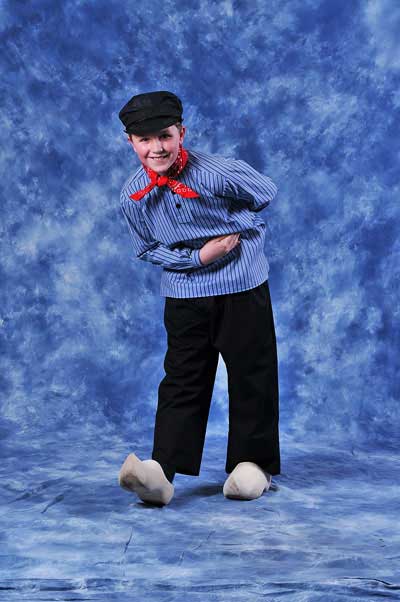 Spakenburg Boy |
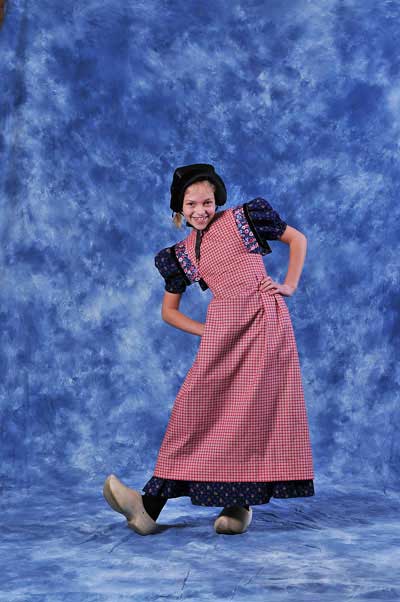 Spakenburg Girl |
Province of Friesland:
Friesland — This beautiful costume from a northern province in The Netherlands gives an indication of the pride of the people of Friesland. The beautiful patterned dress features a fitted bodice with a peplum which drapes longer in the back. The dress is accented by delicate lace on the shawl, apron, and sleeves. There are four hats worn with this costume, the top one a lovely lace hat tightly shirred in the neckline. Beneath the lace hat is a gold hat which originally was a thin gold metal helmet. It should be noted that this was the costume of well-to-do ladies of the city and wealthy farmers’ wives.
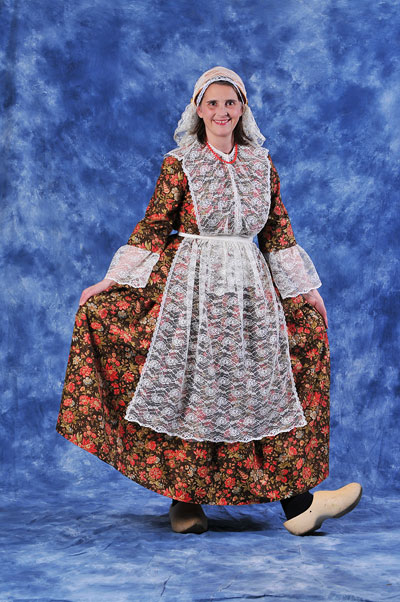 Friesland 1 |
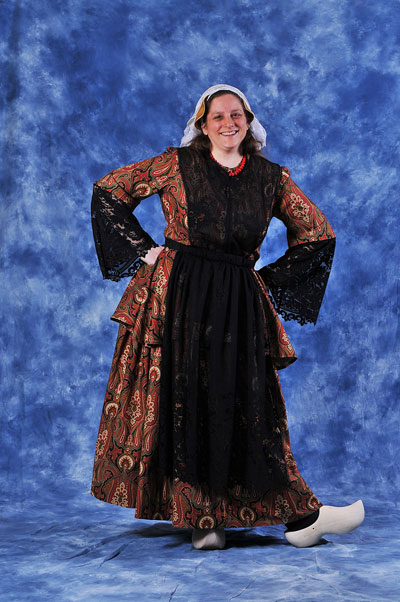
Friesland 2 |
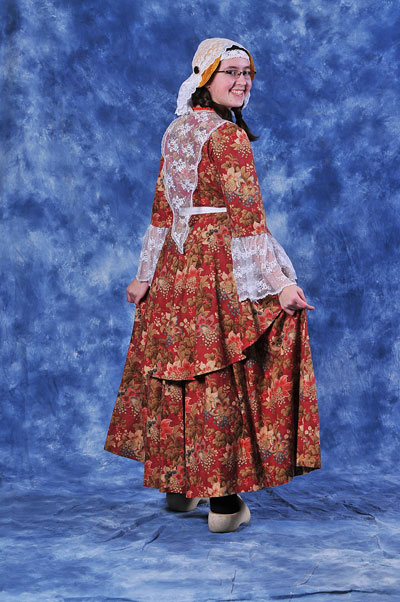
Friesland 3 |
Province of Zeeland:
Middelburg — The colorful costume from this southern province, features a black skirt and blouse highlighted by a brilliantly striped apron and a large white collar. A fitted eyelet hat hugs the head and is adorned by “kissers.”
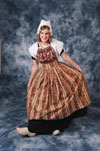
Middelburg 1 |
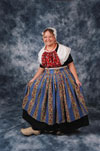
Middelburg 2 |
Walcheren — This dress is worn with a blue and white checked or striped apron and sports a colorful floral dickey. The lovely close-fitting hat flows out loosely over the shoulders. Spiral “kissers” are again worn in the hat, a feature with all the costumes from this area.
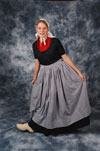
Walcheren 1 |

Walcheren 2 |
Zuid Beveland — This elegant costume is very distinctive with its very beautiful, large, stiffly starched hat. The “kissers” are large gold squares worn at the temples. The detail of the hat in olden days signified whether the person was of the Protestant or Catholic faith. Our hat is hand-made exclusively by one woman, personally taught the technique which was handed down from an immigrant from Zeeland, in The Netherlands. It is the Protestant style.
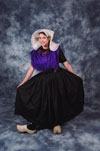
Zuid Beveland 1 |
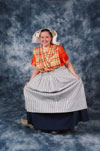
Zuid Beveland 2 |
Province of Noord Holland:
Isle of Marken — The Marken costume from this charming town on the Zuyderzee, now called the IJsselmeer, is the most colorful costume worn in our festival. It features a red and yellow bolero worn with red on the front and blue or burgundy on the back. The black skirt, trimmed with orange, along with a floral accents on the hat and front add to the appeal of this dress. This is one of two costumes which features a shorter skirt.
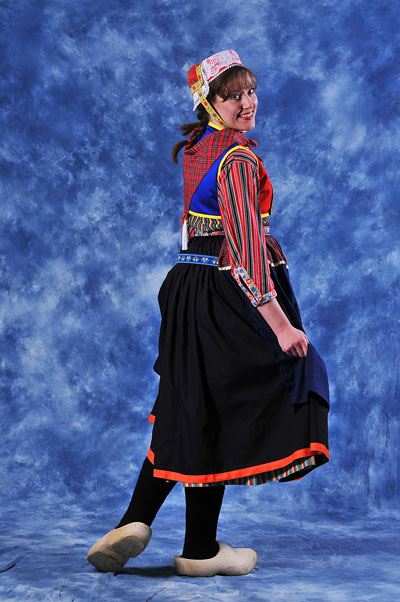 Marken 1
Marken 1 |
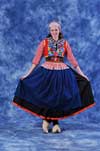
Marken 2 |
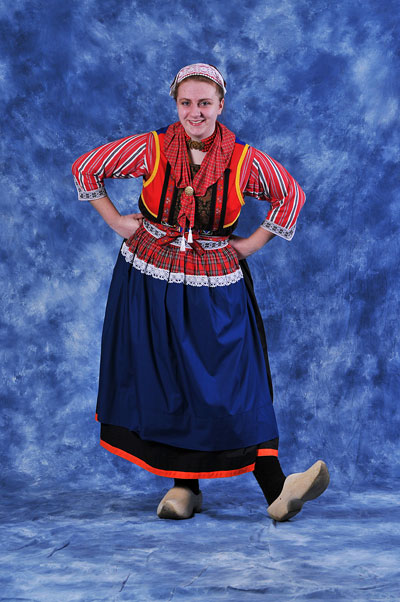
Marken 3 |
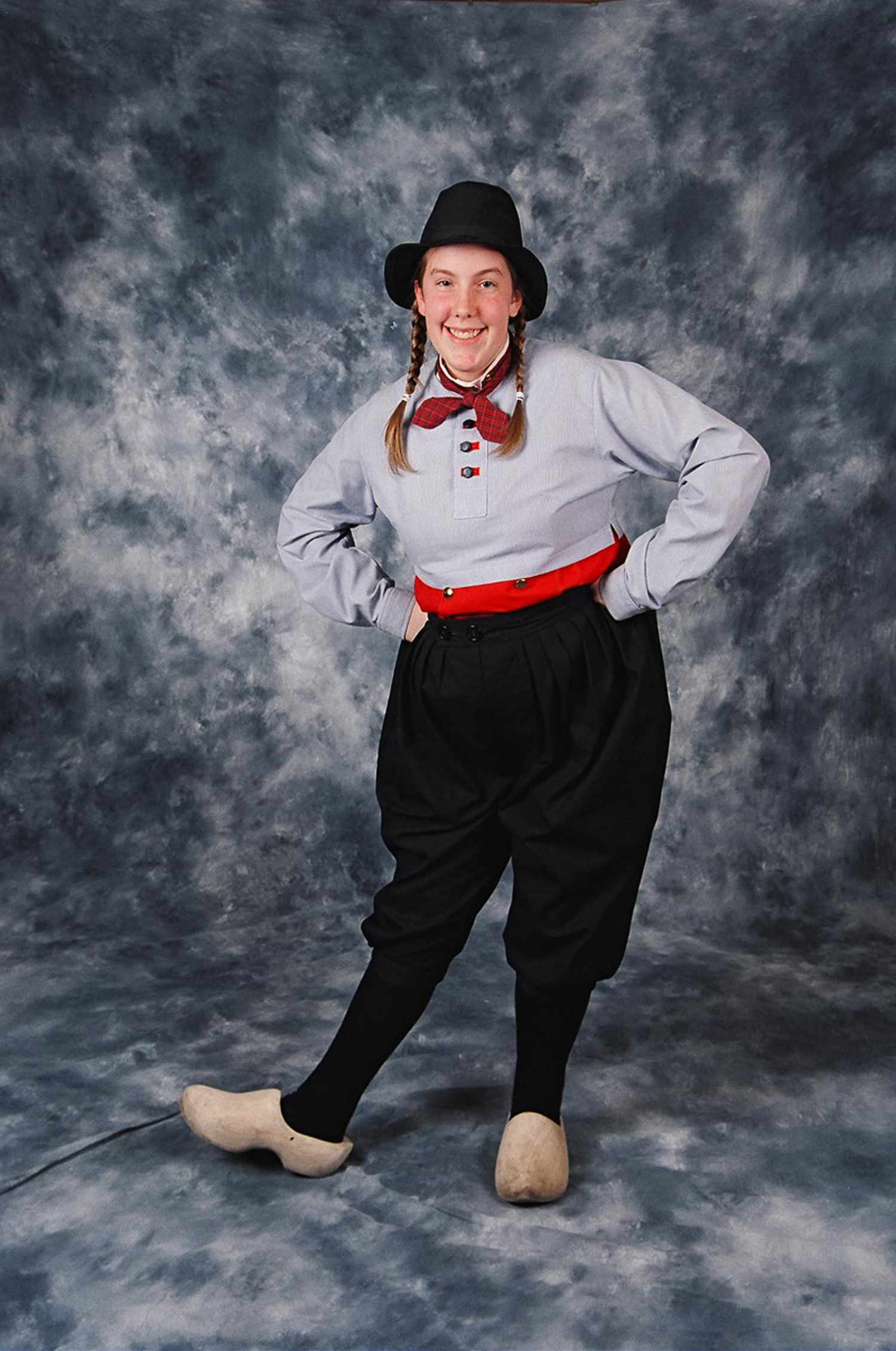
Marken 4 |
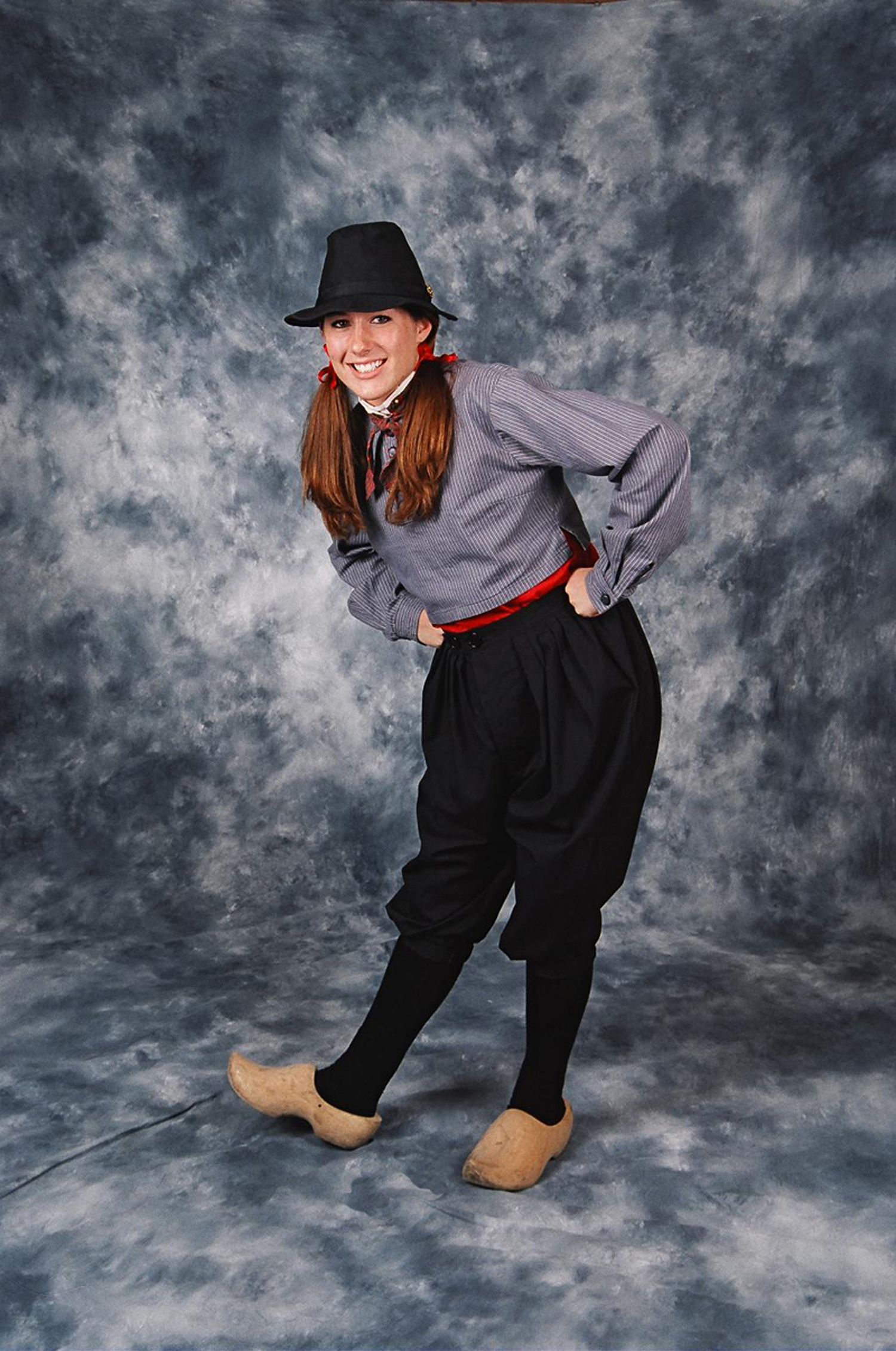
Marken 5 |
The Marken men wear a blue and white or gray and white striped shirt with red patches, red button holes, and red stitching. A white dickey with red plaid braid on the collar is worn underneath the shirt. A double-breasted red vest is worn on top, which shows below the shirt. The costume is finished off with gold buttons and a red scarf. Knicker style front pleated pants with a button fly are worn a little below the waist, which is unlike other pants. A fedora style hat completes this costume.
Volendam — This fishing village not far from Marken is represented in our festival by a girl’s and a boy’s costumes. The girl’s costume has a high peaked lace hat and a brightly striped skirt. The boy’s outfit, c. 1940–1950 is distinguished by a plaid jacket and black pants.
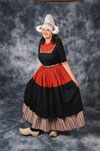
Volendam Female 1 |
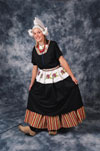
Volendam Female 2 |
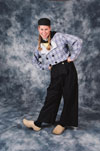
Volendam Male 1 |
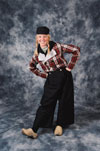
Volendam Male 2 |
Noord Holland — These men’s costumes, introduced in 2007, are also from the Volendam area, but represent an earlier time period, c. 1905. The boy’s c. 1905 “Sunday Best” presents a distinguished black suit with a striped vest underneath. The c.1905 "Workday outfit" is easily identified by its buckskin colored pants and red striped jacket. Both the “Everyday Workday” and the “Sunday Dress” version of this men’s costume were directly reproduced by our costume staff, following careful study of vintage costumes in the Holland, MI Museum.
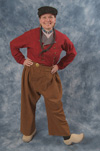
Noord Holland Workday Costume 1 |
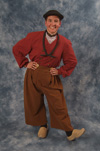
Noord Holland Workday Costume 2 |
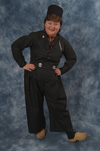
Noord Holland Sunday Costume 1 |
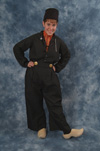
Noord Holland Sunday Costume 2 |
Province of Overijssel:
Staphorst — This close, religious community in The Netherlands keeps to the old ways. A few still wear this costume as everyday dress today. In Staphorst, most of the sewing is done by hand and the floral pieces on the dress are sometimes hand painted. The skills necessary for making these clothes are taught to the girls in secondary school. The dark skirt and blouse is accented by a pretty red plaid scarf and a floral hat and dickey. For a very conservative community it is a bit surprising that this costume features a bright red petticoat. “The Boy’s costume is made of midnight blue or black pants and a long sleeved shirt. There are seven rows of plain or ornamental buttons on the shirt. A red neckerchief, white suspenders and a common fisherman’s hat completes the costume.”
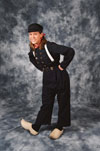
Staphorst Male 1 |
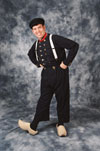
Staphorst Male 2 |
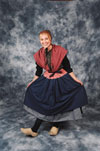
Staphorst Female 1 |
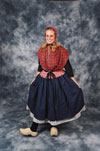
Staphorst Female 2 |
Province of Gelderland:
Achterhoek — This boy’s costume from the central section of The Netherlands and introduced in the 1970s continues to be very popular with our dancers. The rich-looking black brocade vest worn over a blue striped shirt and accented by a red scarf, gives this costume a very handsome appearance.
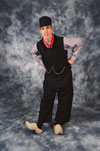
Achterhoek 1 |
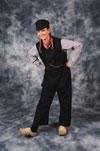
Achterhoek 2 |
Province of Flevoland:
Urk – The fishing village of Urk lies on the east side of the Ijsselmeer in the most recently formed province of Flevoland. The Urk dress features three bodice pieces. one worn on top of the other. The Urk boy’s costume features shorter pants and a jacket of red, black and white stripes, representing the “Urker stripe”.
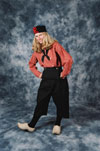
Urk Male 1 |
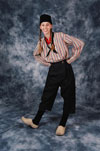
Urk Male 2 |
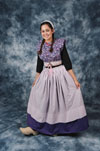
Urk Female 1 |
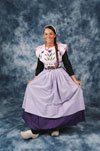
Urk Female 2 |
Province of Groningen:
Groningen — This outfit consists of a close fitting jacket with a peplum attached to it and a matching skirt. The shawl is worn around the girls’ shoulders, while an apron finishes the outfit. The women often wore many petticoats for warmth during the cold winters.
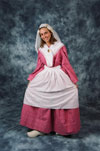
Groningen 1 |
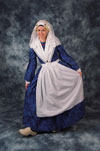
Groningen 2 |
Photos Courtesy of Junebug Photography

